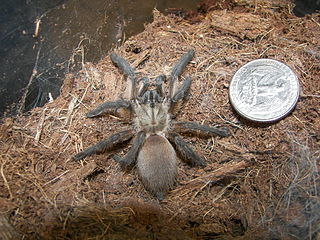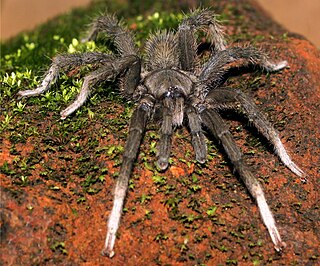
Macrothele is a genus of mygalomorph spiders in the family Macrothelidae, and was first described by A. Ausserer in 1871. Most species occur in Asia, from India to Japan, and Java, with five found in Africa, and two in Europe. The name is derived from Ancient Greek μακρός ("makro-"), meaning "big", and θηλή ("thele"), referring to the spinnerets.

Idiops is a genus of armored trapdoor spiders that was first described by Josef Anton Maximilian Perty in 1833. It is the type genus of the spurred trapdoor spiders, Idiopidae. Idiops is also the most species-rich genus of the family, and is found at widely separated locations in the Neotropics, Afrotropics, Indomalaya and the Middle East. Females live in tubular burrows lined with a thick layer of white silk. These typically have a D-shaped lid that fits into the entrance like a cork, and some burrows have two entrances. The lid may consist of mud, moss or lichen, which is bound below by a thick layer of silk. As in all genera of this family, the anterior lateral eyes (ALE) are situated near the clypeal margin, far in front of the remaining six eyes, which are arranged in a tight group. The males which are smaller in size, wander about or occasionally live in burrows. Like other mygalomorphs, they are relatively large and long-lived. Forest clearance and agricultural practices that loosen the soil and enhance erosion, besides soil removal for brick making have been pointed out as serious threats to some Indian species. Species ranges are poorly known – in India for instance, most species are known only from their type localities.
Heligmomerus is a genus of armored trapdoor spiders that was first described by Eugène Louis Simon in 1892.
The Ischnocolinae are a problematic subfamily of tarantulas. In 1892, Eugène Simon based the group, which he noted was only weakly homogeneous, on the presence of divided tarsal scopulae. This feature was later considered to be plesiomorphic, and both morphological and molecular phylogenetic studies have shown that, as traditionally circumscribed, the subfamily is not monophyletic. A much more narrowly defined Ischnocolinae sensu stricto was proposed in 2014. One of the authors of that proposal subsequently said that no further taxonomic changes should be considered until there had been a more comprehensive sampling of the subfamily. As of January 2021, the status of the Ischnocolinae remains unresolved.
Neoheterophrictus uttarakannada is a species of spiders in the genus Neoheterophrictus from India. It was first described in 2012 by Manju Siliwal, Neha Gupta, & Robert John Raven. Its name comes from the place where it was discovered, Uttara Kannada.
Neoheterophrictus sahyadri is a spider species in the genus Neoheterophrictus. It was first described in 2012 by Manju Siliwal, Neha Gupta, and Robert John Raven. Its name "sahyadri" comes from the vernacular name for the Western Ghats, a mountain range in India where it was discovered.
Neoheterophrictus bhori is a species of tarantula. It is native to Parambiculam, Western Ghats, Cochin province, India, in present-day Kerala state.
Neoheterophrictus crurofulvus is a species of tarantula. It is also the type species of Neoheterophrictus and is found in the Western Ghats, India.

The Eumenophorinae are a subfamily of tarantula spiders. They are known from genera distributed across Sub-Saharan Africa, the south of the Arabian peninsula, Madagascar and its associated islands, and parts of India.
Neoheterophrictus amboli is a species of theraphosid spiders, which is found in India.

Neoheterophrictus smithi is a species of tarantulas, native to India.
Haploclastus psychedelicus, synonym Thrigmopoeus psychedelicus, is a theraphosid spider. It is native to India.
Neoheterophrictus madraspatanus is a species of spider in the family Theraphosidae, found in India.
Plesiophrictus is a genus of tarantulas that was first described by Reginald Innes Pocock in 1899.
Tigidia is a genus of brushed trapdoor spiders first described by Eugène Simon in 1892.

Haploclastus is a genus of Indian tarantulas that was first described by Eugène Louis Simon in 1892. It is considered a senior synonym of Phlogiodes.
Heterophrictus is a genus of Indian tarantulas that was first described by Reginald Innes Pocock in 1900.
Sahydroaraneus is a genus of spiders in the family Theraphosidae. It was first described in 2014 by Mirza & Sanap.
Sahydroaraneus hirsti is a tarantula in the genus Sahydroaraneus, it is named after A. S. Hirst for his contributions in Arachnology. This tarantula is found in Thrissur, India. This tarantula was first described by Mirza and Sanap in 2014.





